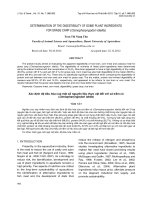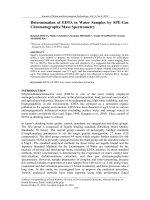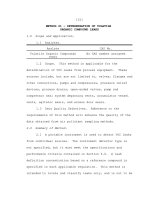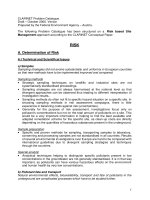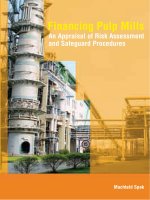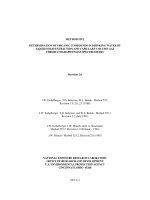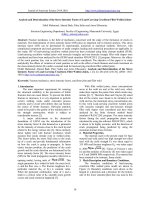Determination of risk
Bạn đang xem bản rút gọn của tài liệu. Xem và tải ngay bản đầy đủ của tài liệu tại đây (40.82 KB, 12 trang )
1
CLARINET Problem Catalogue
Draft – October 2000. Venice
Prepared by the Federal Environment Agency – Austria.
The following Problem Catalogue has been structured on a Risk based Site
Management approach according to the CLARINET Conceptual Paper.
RISK
A. Determination of Risk
A.I Technical and Scientifical Issues
a) Samples
Sampling strategies did not evolve substantially and uniformly in European countries
so that new methods have to be implemented improved and compared.
Sampling methods
• Strategic sampling techniques on landfills and industrial sites are not
systematically standardised proceedings.
• Sampling strategies are not always harmonised at the national level so that
divergent approaches can be observed thus leading to different interpretation of
investigation results
• Sampling methods do often not fit to specific hazard situation on a specific site. In
choosing sampling methods in risk assessment campaigns, there is little
experience in balancing costs against risk (uncertainties).
• Generally for the purpose of risk assessment, investigations focus only on
pollutant’s concentrations but not on the total amount of pollutants on a site. This
would be a very important information in helping to find the best available and
adapted remediation scheme for the specific site, as clean-up costs are directly
depending on the quantities of hazardous substances present in the underground.
Sample preparation
• Specific and proven methods for sampling, transporting samples to laboratory,
conserving and processing samples are not standardised in all countries. Results
of several environmental investigations over Europe are hard to be compared with
international guidelines due to divergent sampling strategies and techniques
through the countries.
Special analytic
• Analytical techniques helping to distinguish specific pollutants present in low
concentrations in the groundwater are not generally standardised. It is in that way
important, as pollutants can have various hazardous effects on the environment
and human health by very low concentrations.
b) Pollutant fate and transport
Natural environmental effects, bioavailability, transport and fate of pollutants in the
underground are complicated processes which have to be studied further.
2
Pollutant transport processes
• Detection of leachate pollution and transfer of contaminants from the unsaturated
zone to groundwater are not enough studied and investigated under field
conditions e.g. in pilot experiments, clear concept for such processes are
generally missing.
• There is no clear evidence on how fare transport models can be used in
investigation campaigns and how efficient they can be, depending on site
conditions. Therefore mathematical verifications of models should be carried out
under field conditions in order to improve their efficiency.
• Site investigations should be done in a way that enable to see the evolution in
time of contamination plume. Interactions between pollutants and its surrounding
media are not well understood. Prediction of possible evolution of a contamination
plume is still very difficult to carry out.
• There is little knowledge in some countries on contaminant’s behaviour in
multiphase transport processes. Especially efficient methods for non aqueous
phase liquids detection are missing.
Pollutant bioavailability
• Modified methodology for assessing differences in bioavailability among different
soils, taking abiotic and biotic aspects into account are not yet available. This is
an important point to determinate bioavailability of contaminants for soil
organisms. This kind of assessment would represent a tool for developing specific
remedial or monitoring actions which would take in account the natural
biodegradation of soil pollutants.
• Bioavailability of pollutants to humans is a complex and yet not enough
understood problem as pollutants are available through a variety of media
(groundwater, soil, air, plants)
• Effective methods for the estimation of pollutant bioavailability for human are
often missing. This would be an important view in order to come to a more precise
risk assessment.
• Objective and methodological investigation methods, assessing negative effects
of contaminated sites on agricultural crops, cattle, house animals and plants in
gardens are not standardised procedures. Such investigation methods would be
an important tool to help setting clean-up target values.
• The transfer mechanisms of pollutants from soil to plant are yet not completely
understood. Studies in laboratory and on field experiemtns are missing.
Pollutant degradation and modification
• Specific investigation tools for appreciation of soil pollutant partitioning and
speciation are difficult to be implemented.
• It is difficult to estimate precisely the role of pollutant fractions in soils (immobile,
mobilisable and mobile) in assessing their impact on soil ecosystems and plants.
Precise and selective risk assessment on sites on which several pollutants are
present are hardly possible.
• There is no sufficient understanding of the behaviour of groundwater pollution
(long term transport, attenuation, adverse effects on local conditions) in
heterogeneous media. A specific planning system taking several natural
environmental effects (biodegradation, dilution, dispersion) as well as human
activities (tunnel building, chemical input in soil etc ) in account, is missing.
3
A.II Risk Assessment
a) Risk assessment methods are not adapted to site heterogeneity (pollutant
variety, complexity of ecosystems and geology)
• Efficient risk assessments are difficult to be carried out in case of the presence on
site of a multitude of pollutants, pollutant fractions and pollution sources. New
methods have to be developed and implemented.
• Rapid pollution detection and a risk evaluation methods for multiple potential
pollution sources are not systematically available.
• Specific procedures for risk assessment are not applied systematically. Risk
assessments are not carried out in function of specific site conditions thus leading
to unnecessary investigations (cost efficiency decreases) or uncomplete
assessment (risk is underestimated).
• The impact of pollutants on soil ecosystems is not predictable in detail and has to
be assessed further by developing new investigation methods.
b) Monitoring of pollutant emissions are not developed enough in order to
enable an efficient risk estimation
• Assessment and monitoring of smells is too expensive and time consuming. New
and efficient methods are missing.
• Risk assessment methods for indoor air pollution caused by contaminated soils or
groundwater have to be developed.
• A better control of emissions from dumping and industrial wastes, as well as
mining waste deposits has to be guarantied. Pollution by heavy metals and
organic compounds are still difficult to assess and to monitor in a way to enable
an efficient risk estimation. Emission of nitrates due to the excessive use of
fertilisers are difficult to be estimated at the regional scale. Their effects on point
source pollution are still not enough investigated.
A.III Special geographical and geological conditions
• Combined risk assessment approaches for radionuclides and heavy
metals/arsenic in former uranium mining regions are not yet implemented.
Exposure assumptions have to be improved and methods for the combined
assessment of deterministic and stochastic effects from both source have to be
developed. The evaluation of combinatory effects of radiation and heavy metals
has to be improved.
• Special site conditions give rise to various types of problems e.g. investigation
plan, risk assessment and remediation planning.
• Contaminated land in fractured rocks and karstic areas are still a main problem
concerning the spreading of contaminants in such heterogeneous geological
structures.
• Overexploitation of coastal aquifers is at the origin of several soil pollution in the
vicinity of the sea. Interactions between seawater and groundwater are yet not
clearly understood and give rise to additional problems in risk assessment
studies.
4
B. Management of Risk
B.I. Managing ecological risks is a fundamental conflict as their accurate
evaluation is still very difficult thus giving rise to uncertainties
a) Interpretation uncertainties of pollutant fate in the underground are still
very high as natural phenomenon occurring in those ecosystems (soil,
aquifer) are highly complex.
• There exist some models to estimate leaching from the unsaturated zone towards
groundwater, from very simple to very complex. It is not very clear how to tackle
the leaching problem during the different phases of soil investigation (from
screening to more quantitative approach). It is not clear in every case whether or
not it is accurate to use databases to describe site conditions. The model’s values
their implementation on different levels of accuracy, and their related expends are
not easy to be determined or estimated. Efficient cost estimation and comparison
methods for various investigation procedures are missing.
• Tools to find out the best available risk assessment strategy with regard to site
specific conditions as well as to uncertainties are missing
• The multiple effects of contaminated soils on ecosystems are not well enough
investigated with regard to the complexity of those ecosystems. Ecosystems
adapt and react very differently to pollution. This natural capacity of ecosystems
has not been studied enough yet as field experiments are lacking.
• Risk-based approaches are not improved sufficiently. The remaining risk
uncertainties have to be minimised in order to enable better application of fitness-
for-use assessments in real life decision making, in particular in human exposure
models.
b) The accuracy and representativity of observation methods (sampling and
measurement methods) have to be improved further
• Sampling methods do generally not fit to specific hazard situation on a specific
site. In choosing sampling methods in risk assessment campaigns, there is little
experience in balancing costs against risk.
• Considering risk management approaches, it is notable that guideline as well as
investigation and intervention values do not always fit to site specific conditions.
Those values are too often differing with the reality of local conditions and
pollutant’s specific environmental impact on site.
• In urban environment, multiple pollution sources are hard to be assessed, as
pollution plumes get mixed and diluted. Integrated risk assessment for multiple
sources have to be improved.
• There is a great difficulty in estimating the spatial origin of soil/groundwater
contamination in combination with complex underground storage tanks systems
upgrading and filling station networks. Efficient monitoring methods to locate the
origin of those contamination are missing.
B.II. The link between risk management and land-use planning has to be
improved.
Specific Decision Support Systems are missing
5
• Risk based fitness for use approaches are still very difficult to implement on site.
This is mainly due to the high uncertainties of pollutants quantitative estimates. In
particular the confidence in the human exposure models should be improved.
• Tools for helping to choose the best available (adjusted) clean-up strategies are
missing.
• Methods to find out the most cost-effective remedial strategies and technologies
with regard to risk have to be developed and improved.
• Practise oriented concepts for contaminated land clean-up are too rarely applied.
Assessments of technical and socio-economic feasibility of different clean-up
solutions with regard to future uses of contaminated land are not systematically
available.
• Decision tools for engineers and more specially for decision making authorities
are sometimes lacking so that there is no help for them to choose between
available technologies for remedial actions, while considering socio-economic
aspects of contaminated land redevelopment.
• For land rehabilitation and planning purposes, the risk analysis has to cope with
the technical and socio-economic feasibility of different soil remediation actions
and final uses. A flexible but specific Decision Support System would be the tool
for different experts to co-operate in planning, and for quantitative environmental
analyses, such as risk assessment, to be properly integrated in the decision
making.
• Risk assessment and risk management are not systematically integrated in all
brownfield redevelopment plans on a long time scale. It is too often forgotten that
former contaminated sites can still represent a threat for the environment in the
future.
• Eco-social aspects of risk acceptance are not taken in account brownfield sites
recycling plans.
• Risk based management of specific contaminated sites are not enough planed in
relation with management schemes of water quality at a basin scale, especially
when different sources of pollution discharge in the same aquifer.
• The use of multiphase transport models as a tool for clean-up planning is yet not
a standardised method of procedure.
• The public expectations are not systematically integrated in the site management
concepts on a contaminated site.
C. Risk Reduction/ Monitoring
C.I Existing methods to be improved
a) Ex-Situ
Proceeding optimisation. Laboratory and field experiments are lacking
• The development of separation and treatment technologies for different kinds of
waste and soil pollution is not very advanced.
• Concepts for handling excavated soils are not carried out in the most efficient way
and have to be developed. It is generally the case that excavated soils are
transported to special deposit plants.
6
Sustainable remediation solutions are lacking
• Transporting excavated soil on other disposal sites is not a long term solution and
should be replaced by alternative sustainable solutions.
• Reuse of contaminated soil material is not systematically taken into consideration.
b) In-Situ/On-Site
Duration of clean-up procedures is often too long
• Combination and optimisation of different treatment methods has not been very
much experienced and would help to shorten clean-up treatment duration.
Proceeding optimisation. Laboratory and field experiments are lacking
• Groundwater denitrification technologies have yet not reached a very high
standard level. Neither laboratory nor field scale improvement experiments of
those technologies are sufficiently carried out. In-situ as much as on-site
technologies have to be developed.
• Physio-chemical techniques are not well enough developed and should be tested
and implemented in a greater extend on contaminated sites.
• Gentle remediation techniques (biochemical and physio-chemical) are not
improved enough.
Site heterogeneity is difficult to handle
• Clean-up techniques of fine grain sized compact soils contaminated with highly
volatile hydrocarbons are not always efficient so that they should be improved.
• The use of bioremediation techniques is severely limited by environment agency
and owner of contaminated sites because this method leads to an uncompleted
removal of the pollutants (non bio-available pollutants).
• There is not enough experience in on-site remediation techniques of groundwater
contaminated by municipal disposal sites at different layers and levels.
• On-site treatments for low permeable soils are not well developed.
• There is a lack of experience in the evaluation of the efficiency of in-situ
bioremediation technologies in heterogeneous systems.
Sustainable remediation solutions are lacking
• Remediation techniques focused on resource optimisation are not enough
developed yet.
Verification methods for clean-up success have to be improved
• In-Situ remediation technologies are too often left aside due to remaining
uncertainties on their efficiency.
• There is a lack of experience in the evaluation of the efficiency of in-situ
bioremediation technologies in heterogeneous systems.
• Efficient evaluation methods for long term efficiency of enclosure systems and
permeable reactive barriers are missing.
c) Monitoring
Verification methods for clean-up success have to be developed and improved
• There are no standardised monitoring methods for verifying soil and groundwater
quality in the vicinity of contaminated sites.
7
• There is insufficient knowledge regarding natural attenuation processes in
groundwater systems at contaminated sites.
• Cost effective monitoring strategies concerning possibilities and limits of natural
attenuation are not existing yet and have to be developed.
Proceeding optimisation. Laboratory and field experiments are lacking
• An efficient monitoring system for the geochemical and ecological conditions
throughout the river catchment areas, regarding the threat of pollution caused by
mining sites is often missing. An important issue is the evaluation of the governing
transport and attenuation processes on a large areal scale.
• Monitoring methods for characterisation of emissions from anthropogenic
sources, industrial activities and their mixing with seawater have to be improved.
• There are no rapid pollution detection methods concerning the leakage of fuels
from underground storage tanks.
Site heterogeneity is difficult to handle
• The variability of groundwater pollution is not well known. A better understanding
of the problem might be possible with the development of a permanent monitoring
system giving information on the evolution of groundwater pollution on the long
time scale.
C.II Choice for new concepts
Proceeding optimisation. Laboratory and field experiments are lacking
• Demonstration sites for clean-up technologies are not available in sufficient
number. These sites would allow to observe pollutant’s behaviour in different
environmental conditions under application of various clean-up measures.
• Innovative technologies (various technologies) for the remediation of sites
contaminated by heavy metals have to be developed.
• Practical application of phytoremediation technologies and their combination with
other in-situ clean up methods for contaminated soils have to be further
developed and improved.
Sustainable remediation solutions are lacking
• Sustainable techniques for the treatment of persistent pollutants as MTBE (Methyl
Tertiary Butyl Ether) are not available.
• Integrative concepts considering technical aspects (site remediation and site
improvement for construction) for reintegration of rehabilitated sites into the
economic cycle have to be developed in order to be more cost efficient with
regard to the rehabilitation of abandoned sites.
Reliability of remediation techniques is not optimal
• Clean-up designs are not always adapted to the specific site conditions,
especially with regard to security and health protection.
SITE
8
A. A few contaminated sites present particular problems to
contaminated land management schemes due to the specific nature
of contaminants
• A combined risk assessment approach for radionuclides and heavy
metals/arsenic in former uranium mining sites is necessary.
• The treatment of mining wastes is still causing technical problems. Especially
sulphates and heavy metals represent particular harm for the environment.
• The continuous raising amounts of mining wastes represent a major problem to
environmental authorities as the behaviour in the environment of released
dangerous acids and heavy metals is not sufficiently understood.
• Special measures for the treatment of abandoned mining sites in sub-arctic areas
have to be found. The use of explosives on mining sites led to emissions of
nitrogen and petroleum products thus resulting in additional threat for the
environment.
• Investigation and rehabilitation of creosote on impregnating installation and
gasworks has to be improved.
• Characterisation and assessments of industrial landfills polluted with heavy
metals, solvents, water soluble metals and hydrocarbons, aromatic compounds
and PAH are still difficult and would need to be verified and improved.
• The use of lignite in energy production is a main source for contamination
problems for which adapted investigation and remediation techniques have to be
developed and improved.
• There is little knowledge on the behaviour of heavy metal solvents in the
underground. Risk assessment is difficult to be carried out for such hazardous
substances.
B. A few contaminated sites present particular problems to
contaminated land management schemes due to the type of activity
on the site and/or site specific conditions
• Large scale problems: contamination of groundwater caused by farming and
zootechnic activities are difficult to be assessed.
• Characterisation and remediation of a large number of abandoned uncontrolled
and illegal waste landfills are difficult to be carried out because of the high variety
of harmful substances present on such sites.
• Industrially contaminated sites in coastal areas are under the influence of
seawater thus leading to interactions on contaminated groundwater. Risk
assessment in such areas is therefore very difficult. New specific investigation
and assessment methods have to be adapted to such special conditions.
• Estimating the influence of rising groundwater tables in urban areas where there
is land contamination is still a difficult procedure. Reliable investigation techniques
are missing.
• Mining sites represent an important source of local soil pollution; the main threat
is surface and groundwater contamination. The transport of pollutants on such
sites is very much influenced by modification of the soil/underground structure
thus making risk assessment even more difficult.
9
• Pollution of surface water caused by contaminated sediments as well as the
spreading of contaminants by sediment transfer in harbours (especially metal-
organic compounds) is at the origin of numerous problems for investigations and
risk assessments. Surface water pollution caused by desorption from
contaminated sediments is mostly either ignored or overestimated and leads to
inadequate remediation measures. Therefore, better methods for the quantitative
assessment of surface water pollution caused by contaminated sediments is
highly needed.
MANAGEMENT
A. Administration
A.I Legislative Framework
a) Harmonisation of acts and guidelines
• There is no harmonised concept for handling excavated soil. Conflicts do exist
between waste management acts and soil protection acts through Europe. In
several countries the actual laws regulating the soil remediation are not soil
oriented but concern the waste management.
• The compliance of groundwater and soil quality standards with risk based
procedure for land rehabilitation is not always guaranteed.
• Comparison studies E.U. wide on the toxicological criteria used for the setting of
soil standards are missing.
• There are no technical guidelines for the risk oriented characterisation of
contaminated sites. In some countries the risk assessment approach in
estimating site specific remedial targets doesn’t fit to the latest national
standards. A homogenous European regulation for the risk oriented
characterisation of contaminated sites seems to be necessary.
• Standards values should be differentiated for different geological layers and for
different regions.
b) Technical, economic and legislative tools for the redevelopment of
contaminated sites are missed by decision makers and planners
• Concepts to avoid the increasing consumption of land by recycling brownfield
sites have to be developed.
• Ecological balance aspects are missing in the legislative framework on brownfield
rehabilitation.
• Integrative concepts for reintegration of rehabilitated sites into the economic
cycle have to be developed.
• Although immense surfaces are registered as derelict land through Europe,
green-land consumption is still growing every year. The threat that industrialised
and highly urbanised countries will be faced with land planning problems in cities
is great. Management tools taking care of derelict land surfaces are missing for
decision makers.
10
• Scientific proven tools for identifying the responsible parties for contamination are
missing. Those tools are necessary to help the authorities to enforce the polluter-
pays-principle for land remediation in particular in the brownfields situation.
• The implementation of in-situ physio-chemical techniques often hurt the local
authority’s sanction. Getting special permission from those authorities is often
very time consuming. Administrative ways should be shortcut.
• Regulation tools (acts, guidelines) for implementation of ecological quality
standards are lacking or have to be reviewed
• Legislative tools for investigations and criminal action measures on contaminated
sites have to be improved
c) Financial and legal guaranties for investors are missing
• There exist a legal and also economic problem between brownfields and
greenland redevelopment. There is a competition between greenlands and
brownfields as the economical and legal risks are higher for investors by buying
brownfields.
A.II Structural organisation
Co-operation strategies among different institutional levels are not improved
• The management and co-ordination efficiency of public control authorities is not
organised very efficiently, new organisation models have to be developed and
harmonised.
• Efficient management systems of public funds among different institutional levels
are necessary for implementing effective and specific remediation measures.
The problem is more specifically to get the right amount of money at the right
place at the right time in order to keep the clean-up schedule to other needs of
society especially in the case of brownfield redevelopment.
• Contaminated land management skills of local administrators can’t be considered
as sufficient in many countries considering the complexity of the problems.
Scientific, legislative as well as administrative basics should be part of an
education program.
B. Communication
B.I Public Relations
a) The public concerned by a contaminated site is not enough involved in the
process of site management
• Public acceptance of remedial objectives and future land planing, technical
remedial measures, adverse environmental side effects, nuisances e.g. noise
pollution is not considered enough by planning rehabilitation measures on a
contaminated site.
b) The general public is not well informed about the risk associated to
contaminated sites in general
11
• School education, research on environmental risk issues and general public
information on risk perception is not enough developed. Specific educational and
national research programs are still lacking.
• Estimations on how the environmental risk perception is understood by the
general public are lacking. There is no feed-back from the public towards the
contaminated land managers. Public’s perception of risk is not integrated in
contaminated land management schemes.
B.II Dissemination of information and database availability concerning
contaminated land is not sufficient in all countries
a) Information flow from more experiencd countries to lower experienced
countries should be improved
• An international platform for the exchange of information between countries,
specialised organisations, private companies and public authorities has to be
developed and maintained.
b) At the national level information on contaminated land are not
systematically easily reachable for all stakeholders involved in a project
• Transparent tools for information and data transfer and exchange are missing. All
information available on contaminated sites should be centralised and made
available for all national stakeholders.
• Centralised data base systems on contaminated site investigations and
remediations activities have to be created.
• Information on tested and efficient remediation technologies are not available.
• An overview of the situation concerning brownfields and regulatory and financial
framework is not existing in many member states.
- the dimension of brownfield problems is not known yet
• Problems in the redevelopment of brownfields:
- lack of site-specific information on the environmental condition of land
- absence of mechanisms that foster the alliance among stakeholders
B.III Links between field work and laboratory experiments
Relation between engineering offices / cleaning companies and research
institutes
• Structures for information exchange between experimental level of upcoming
technologies and their application on field are missing. Information exchanges
have to be improved in order to assure efficient investment in remediation
technologies. Co-ordination between company expectations and research
orientations has to be improved.
C. Financial aspects / costs
C.I Sustainable and efficient financing models for redevelopment of formerly
contaminated land are often not available
12
• Socio-economic rehabilitation plans of several industrial areas are missing.
• Many of the national interest sites through Europe represent abandoned
industrial contaminated land to be redeveloped. In these areas integrative
concepts for reintegration of rehabilitated sites into the economic cycle are often
missing. It can be summarised that this issue is linked to the problems of
decreased industrial production and unemployment. The regions concerned are
missing new economic activities.
• Effective methods for cost sharing of groundwater clean-up among different site
and problem owners on intensively industrialised areas are lacking.
• The general legal framework in which a contaminated site release is made has to
be clarified. It is yet not clear who is going to be responsible for the clean-up
funding and who will be reliable for the contamination after a release. The
potential investors could therefore be very reluctant for buying brownfield sites.
The economical and legal risks are not predictable.
C.II Cost efficiency
• Instruments that enable objective estimates of risks, costs and benefits for
cleaning-up contaminated sites have to be developed and optimised.
• There is no tool available for the assessment of technical and socio-economic
feasibility of different clean-up solutions according to land use.
